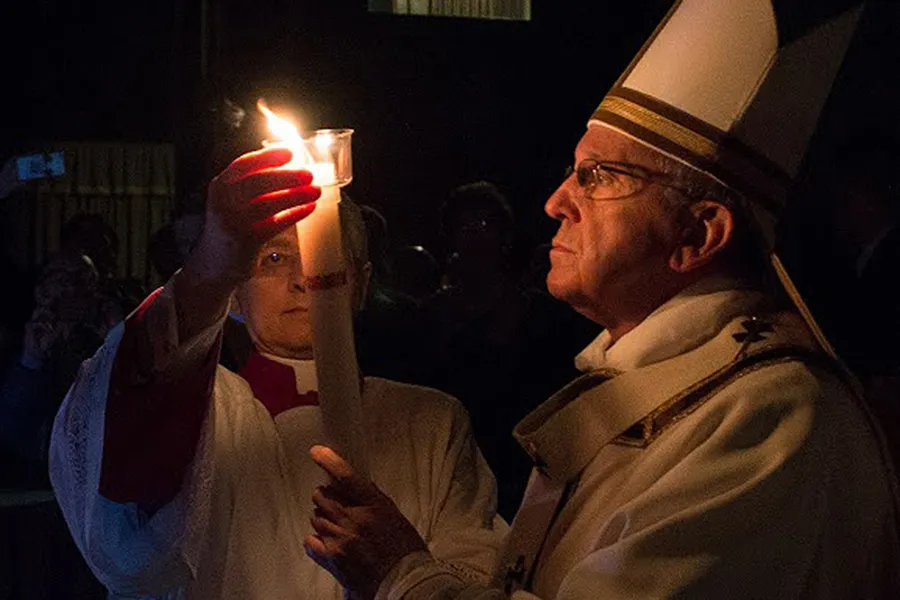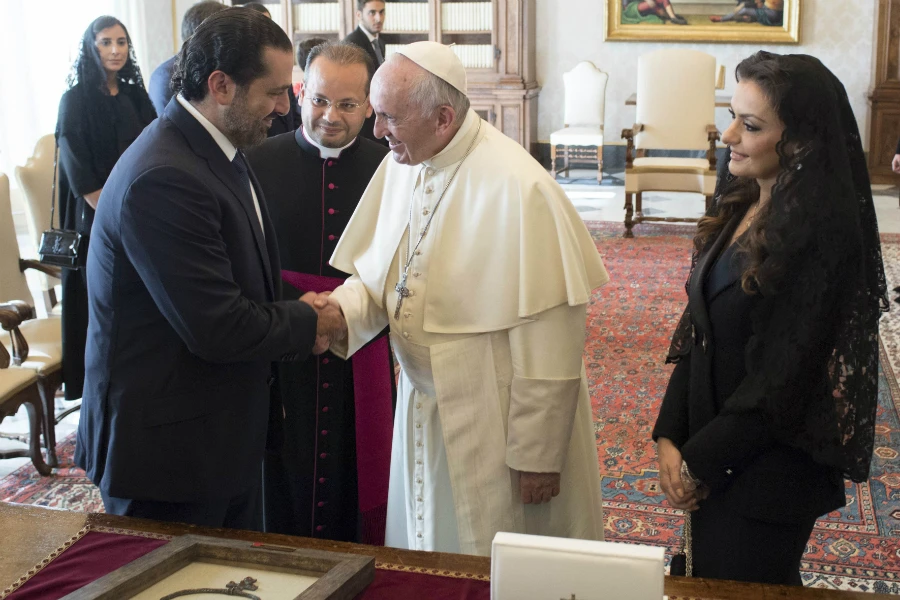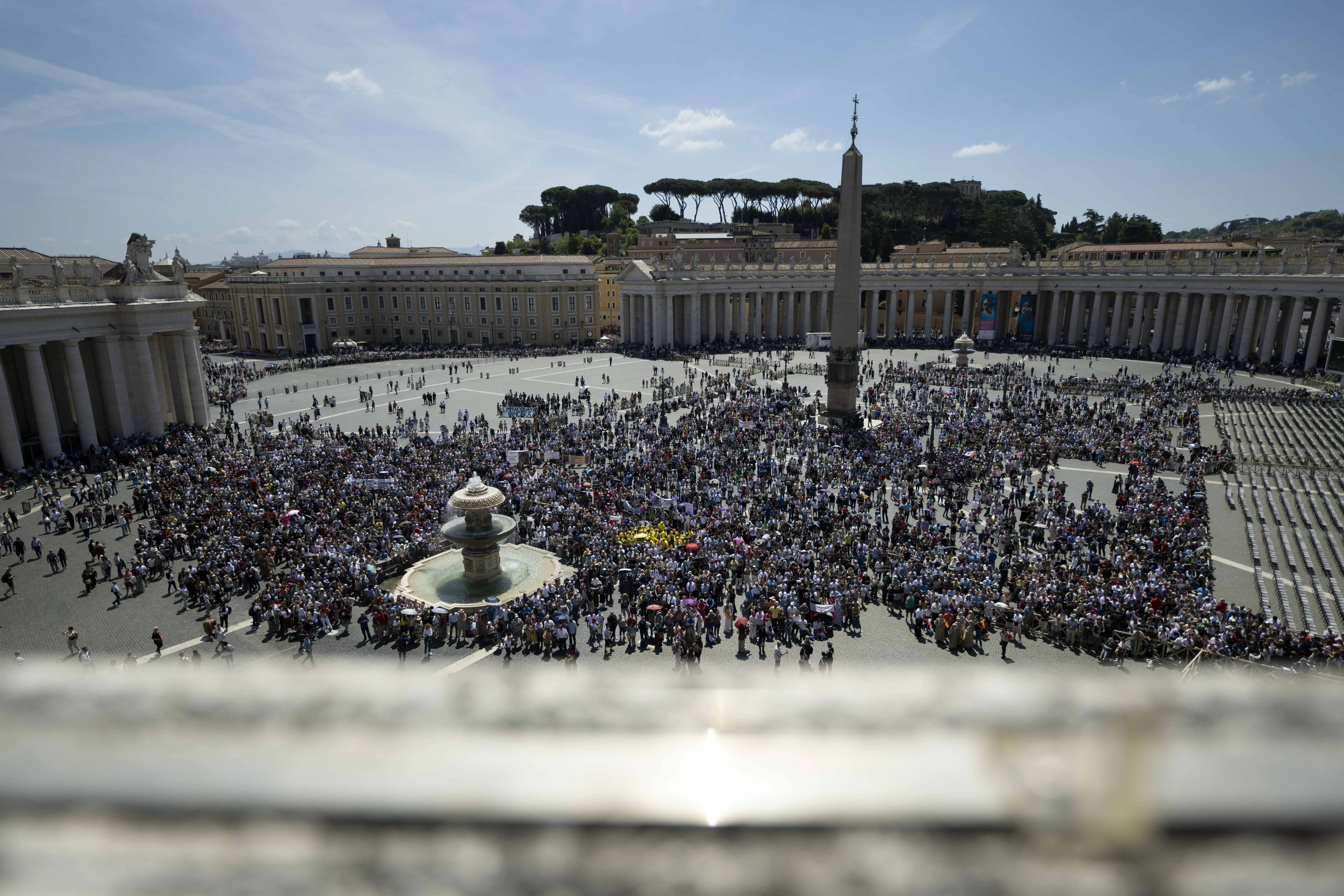
Vatican City, Apr 15, 2017 / 01:46 pm (CNA/EWTN News).- During Easter Vigil at the Vatican Pope Francis noted that many people today mirror the sadness and grief of the women who went to Jesus' tomb thinking he was still dead.
However, the Resurrection, he said, offers new hope for those who have perhaps lost it.
“That is what this night calls us to proclaim: the heartbeat of the Risen Lord. Christ is alive!” the Pope said April 15.
It is the excitement of this message, he said, that made them hurry back to tell the others that Jesus had risen: “That is what made them return in haste to tell the news. That is what made them lay aside their mournful gait and sad looks. They returned to the city to meet up with the others.”
Like the women, each us has also visited the tomb during the vigil, he said, and urged Christians to “go back” with the women into their cities with news of Jesus’ rising.
“Let us all retrace our steps and change the look on our faces,” he said. “Let us go back with them to tell the news in all those places where the grave seems to have the final word, where death seems the only way out.”
The Pope told them go back and proclaim the truth that “the Lord is alive! He is living and he wants to rise again in all those faces that have buried hope, buried dreams, buried dignity.”
“If we cannot let the Spirit lead us on this road, then we are not Christians,” he said.
Pope Francis spoke during his homily for the Easter Vigil, which he celebrated, as usual, in St. Peter's Basilica as the culmination of his Holy Week events. Apart from the vigil, Pope Francis will also celebrate Mass in St. Peter’s Square Easter morning and give his traditional “Urbi et Orbi” blessing.
After delivering his homily, Pope Francis administered the Sacraments of Initiation – Baptism, Confirmation and the Eucharist – to 11 people, one of whom, Ali Acacius Damavandy, is from the United States.
In his homily, Pope Francis said that as Mary Magdalene and the other Mary went to the tomb in the day’s Gospel reading from Matthew, it’s easy to imagine their uncertain steps and their “pale and tearful” faces.
These women didn’t run away, but remained steadfast, and were people that had took life as it came and “knew the bitter taste of injustice.” However, they were still unable to accept Jesus’ death, he said.
By imagining the scene as it plays out, we can picture in the faces of these two women the faces of many others who “bear the grievous burden of injustice and brutality,” he said.
“In their faces we can see reflected all those who, walking the streets of our cities, feel the pain of dire poverty, the sorrow born of exploitation and human trafficking,” Francis said, explaining that we can also see the reflection of those treated with “contempt” because they are immigrants.
“We see faces whose eyes bespeak loneliness and abandonment, because their hands are creased with wrinkles,” he continued.
The faces of these women also mirror “the faces of women, mothers, who weep as they see the lives of their children crushed by massive corruption that strips them of their rights and shatters their dreams. By daily acts of selfishness that crucify and then bury people’s hopes. By paralyzing and barren bureaucracies that stand in the way of change.”
Francis pointed to the pain of all those “who, walking the streets of our cities, behold human dignity crucified,” saying this is also reflected in the grief experienced by the two women.
The women can also represent the faces of each of us personally, he said, explaining that like them, many of us can feel driven to continue walking forward and not to resign ourselves to the fact that “things have to end this way.”
While we carry God’s promise of faithfulness inside of us, our faces, the Pope said, often we bear the mark of various wounds, including infidelity on our part or the part of another, or of battles we have lost.
“In our hearts, we know that things can be different but, almost without noticing it, we can grow accustomed to living with the tomb, living with frustration,” he said, noting that even worse, we can also convince ourselves that “this is the law of life.”
By doing so, we “blunt our consciences with forms of escape that only serve to dampen the hope that God has entrusted to us,” and walk, like the women did, the line between the desire for God and “bleak resignation.”
However, with the Resurrection the women suddenly and unexpectedly feel “a powerful tremor,” and hear a voice telling them not to be afraid, because Jesus has risen from the dead.
The message: “Do not be afraid, brothers and sisters; he is risen as he said!” is one that has been passed on from generation to generation, Pope Francis said, explaining that “life, which death destroyed on the cross, now reawakens and pulsates anew.”
“The heartbeat of the Risen Lord is granted us as a gift, a present, a new horizon,” he said, explaining that this heart is given to us and in turn, we are also asked to give it to others as “the leaven of a new humanity.”
In his Resurrection, Christ not only rolled back the stone to the tomb, Francis said, but he also wants “to break down all the walls that keep us locked in our sterile pessimism, in our carefully constructed ivory towers that isolate us from life, in our compulsive need for security and in boundless ambition that can make us compromise the dignity of others.”
Precisely when the religious leaders of the day, in collusion with the Romans, thought they they had the last word, God enters and “upsets all the rules and offers new possibilities,” the Pope said. “God once more comes to meet us, to create and consolidate a new age, the age of mercy.”
This, he said, is the promise that has been present from the beginning and which is “God’s surprise” for his people.
Pope Francis closed by saying that hidden in every life there is a seed of the Resurrection, “an offer of life ready to be awakened.”
He prayed that all would allow themselves to be surprised by this “this new dawn and by the newness that Christ alone can give,” and asked that we not only allow Christ’s loving tenderness to guide our steps, but that we also “allow the beating of his heart to quicken our faintness of heart.”
If you value the news and views Catholic World Report provides, please consider donating to support our efforts. Your contribution will help us continue to make CWR available to all readers worldwide for free, without a subscription. Thank you for your generosity!
Click here for more information on donating to CWR. Click here to sign up for our newsletter.








Leave a Reply